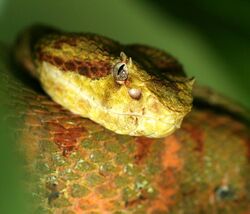Biology:Bothriechis supraciliaris
| Bothriechis supraciliaris | |
|---|---|

| |
| Scientific classification | |
| Domain: | Eukaryota |
| Kingdom: | Animalia |
| Phylum: | Chordata |
| Class: | Reptilia |
| Order: | Squamata |
| Suborder: | Serpentes |
| Family: | Viperidae |
| Genus: | Bothriechis |
| Species: | B. supraciliaris
|
| Binomial name | |
| Bothriechis supraciliaris (Taylor, 1954)
| |
| Synonyms[2] | |
| |
Bothriechis supraciliaris, commonly known as the blotched palm-pit viper and blotched palm-pitviper, is a species of venomous snake in the subfamily Crotalinae of the family Viperidae. The species is endemic to southern Pacific parts of Talamanca Mountain Range in Costa Rica and western Panama.[1][3] No subspecies are recognized.[2][4][5][6]
Description
Bothriechis supraciliaris is usually 50–60 cm (20–24 in) in total length (including tail), but can reach 80 cm (31 in).[7] Its body colour varies. It can be either bluish-green, reddish-brown, or reddish-maroon, but usually it is bright-green or moss-green. The body is circular, ovoid and rhomboid in cross-section, with irregular dorsal blotches, that sometimes form crossbands. The belly is light. There are 21–23 dorsal scales rows at midbody. The head carries dark stripes and prominent scales that are located above the eyes.[7] The only sexual dimorphism noted is that females of the species tend to be longer and thicker than males.[8]
Geographic range
The geographic range of B. supraciliaris is limited to southern Costa Rica (between San Isidro and San Vito) and western Panama.[1]
Taxonomy
Bothriechis supraciliaris was formerly considered a subspecies of B. schlegelii, the eyelash palm-pitviper.[2][4][9]
References
- ↑ 1.0 1.1 1.2 Solórzano, A.; Porras, L.W.; Chaves, G.; Acosta Chaves, V. (2021). "Bothriechis supraciliaris". IUCN Red List of Threatened Species 2021: e.T203661A15875283. doi:10.2305/IUCN.UK.2021-3.RLTS.T203661A15875283.en. https://www.iucnredlist.org/species/203661/15875283. Retrieved 17 December 2023.
- ↑ 2.0 2.1 2.2 Bothriechis supraciliaris at the Reptarium.cz Reptile Database. Accessed 17 December 2023.
- ↑ Twan Leenders: Reptiles of Costa Rica, Cornell University Press, Ithaca & London, 2019. ISBN 978-0-9894408-4-4.
- ↑ 4.0 4.1 O'Shea, Mark (March 2008). Venomous Snakes of the World. New Holland Publishers. p. 41. ISBN 978-1-84773-086-2. https://books.google.com/books?id=IoC4vAEACAAJ.
- ↑ "Taxonomic Information for Bothriechis supraciliaris". Encyclopedia of Life. http://eol.org/pages/11006908/names. Retrieved 17 December 2023.
- ↑ Lomonte, Bruno; Tsai, Wan-Chih; Bonilla, Fabián; Solórzano, Alejandro; Solano, Gabriela; Angulo, Yamileth; Gutiérrez, José María; Calvete, Juan J. (2012). "Snake venomics and toxicological profiling of the arboreal pitviper Bothriechis supraciliaris from Costa Rica". Toxicon 59 (5): 592–599. doi:10.1016/j.toxicon.2012.01.005. PMID 22333435.
- ↑ 7.0 7.1 "Bothriechis supraciliaris". AFPMB Living Hazards Database. Armed Forces Pest Management Board. http://www.afpmb.org/content/venomous-animals-b#Bothriechissupraciliaris. Retrieved 9 January 2014.
- ↑ Solórzano, Alejandro; Gómez, Luis D.; Monge-Nájera, Julián; Crother, Brian I. (1998). "Redescription and validation of Bothriechis supraciliaris". Revista de Biología Tropical 46 (2): 1001–1013. http://www.scielo.sa.cr/scielo.php?pid=S0034-77441998000200029&script=sci_arttext.
- ↑ Lillywhite, Harvey B. (April 2014). How Snakes Work: Structure, Function and Behavior of the World's Snakes. Oxford University Press. p. 25. ISBN 978-0-19-538037-8. https://books.google.com/books?id=RG9VAgAAQBAJ&pg=PA25.
Further reading
- Taylor EH. (1954). "Further Studies on the Serpents of Costa Rica". Univ. Kansas Sci. Bull. 36 (11): 673–800. (Bothrops schlegelii supraciliaris, new subspecies, pp. 791–794, Figure 39).
Wikidata ☰ Q2911670 entry
 |


